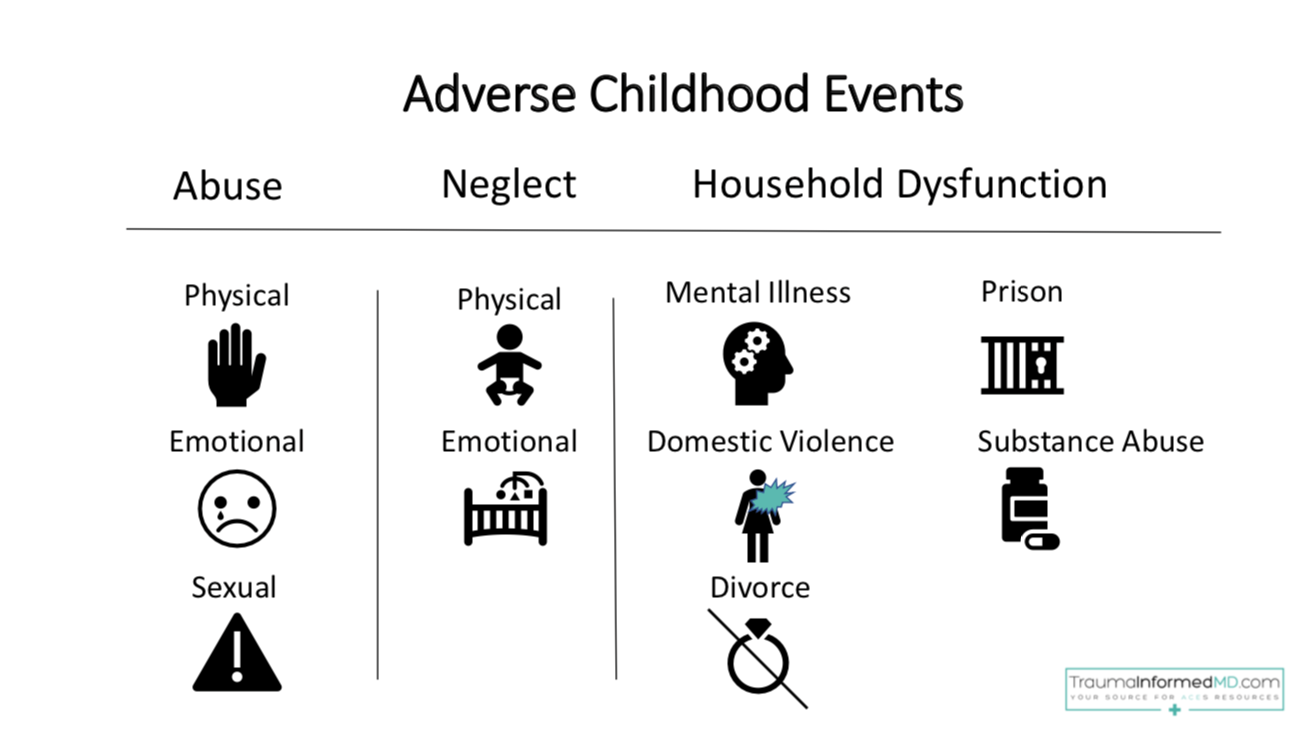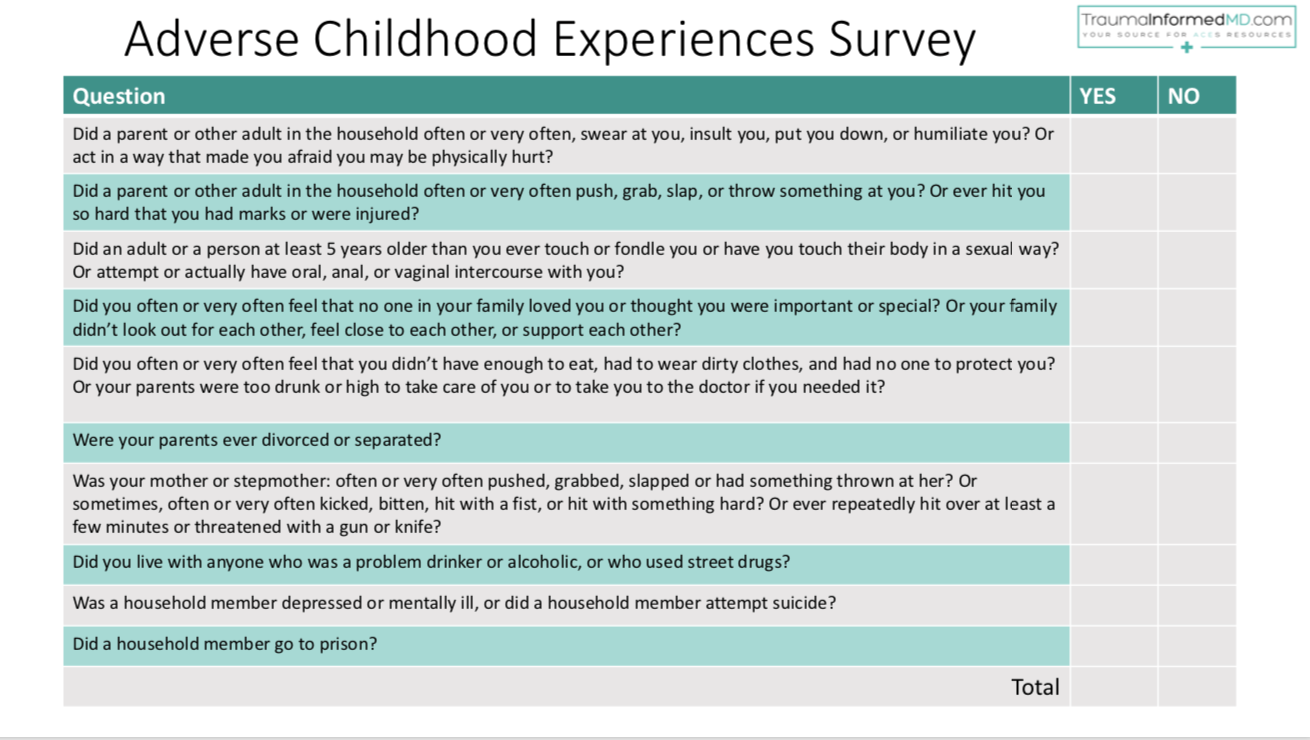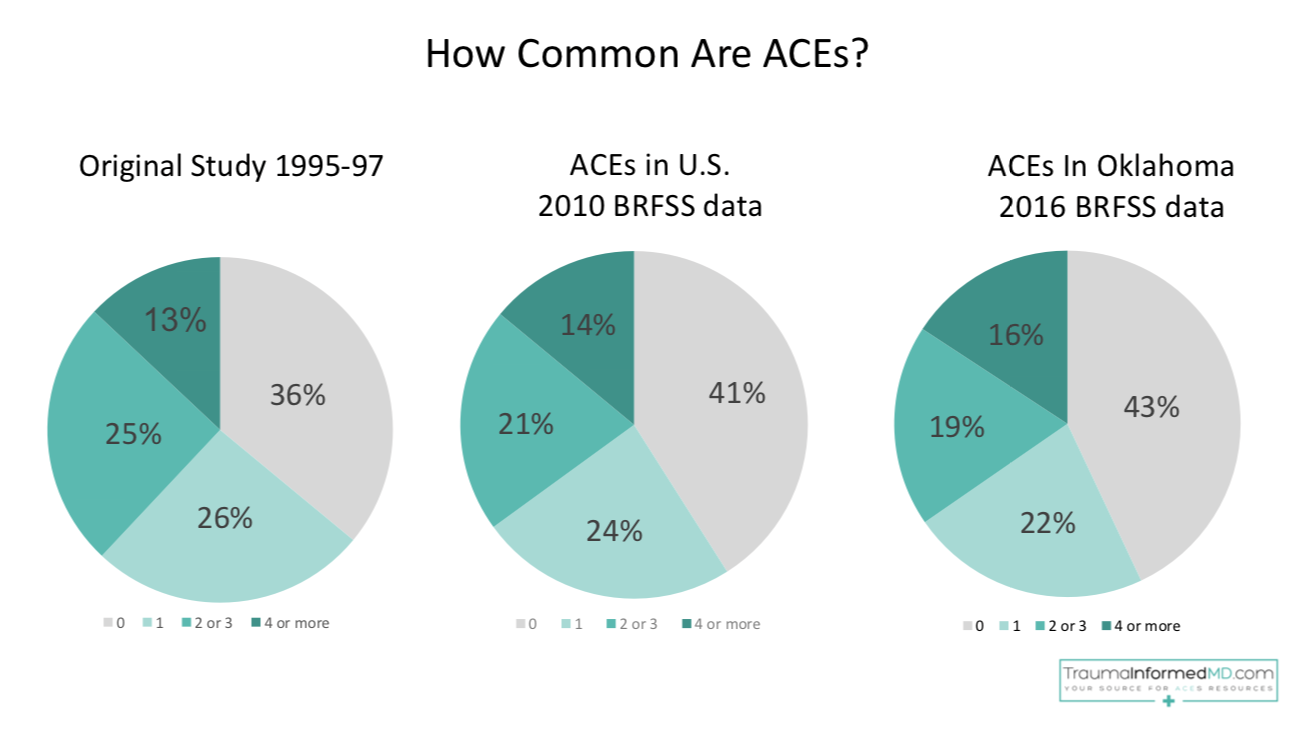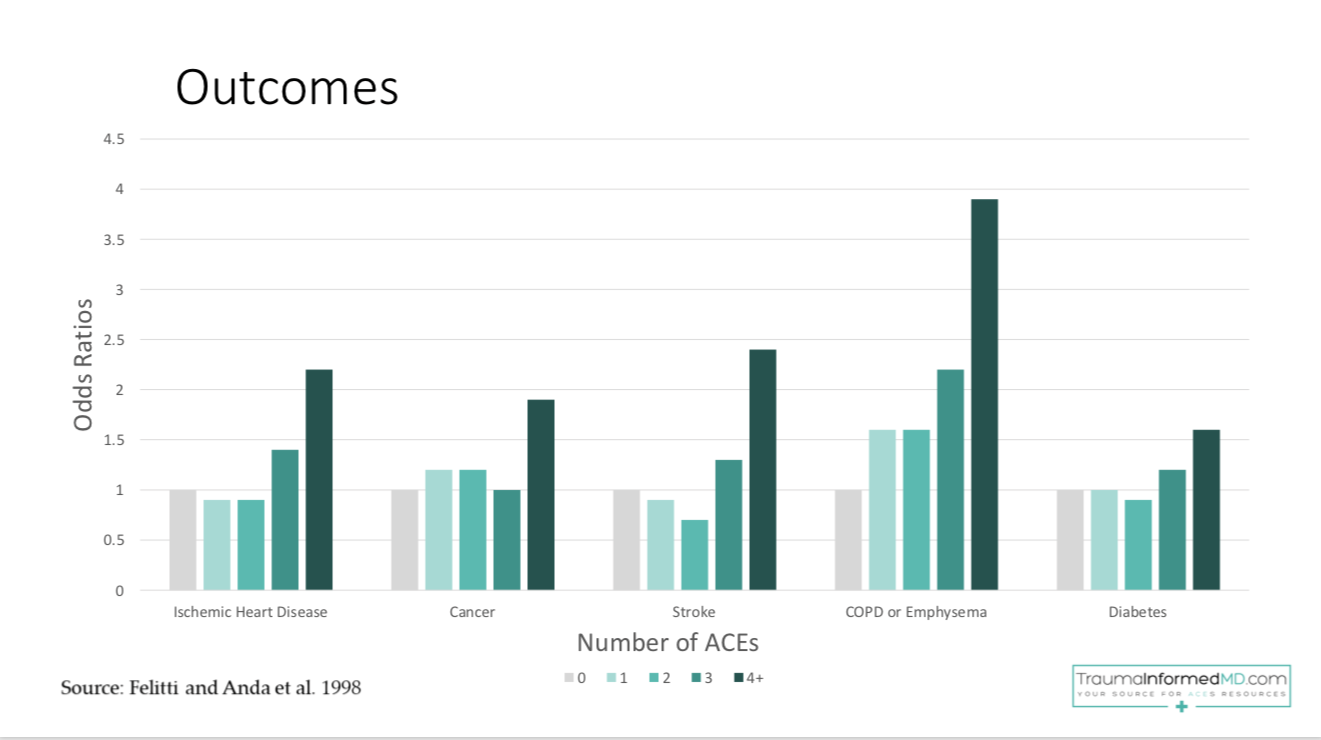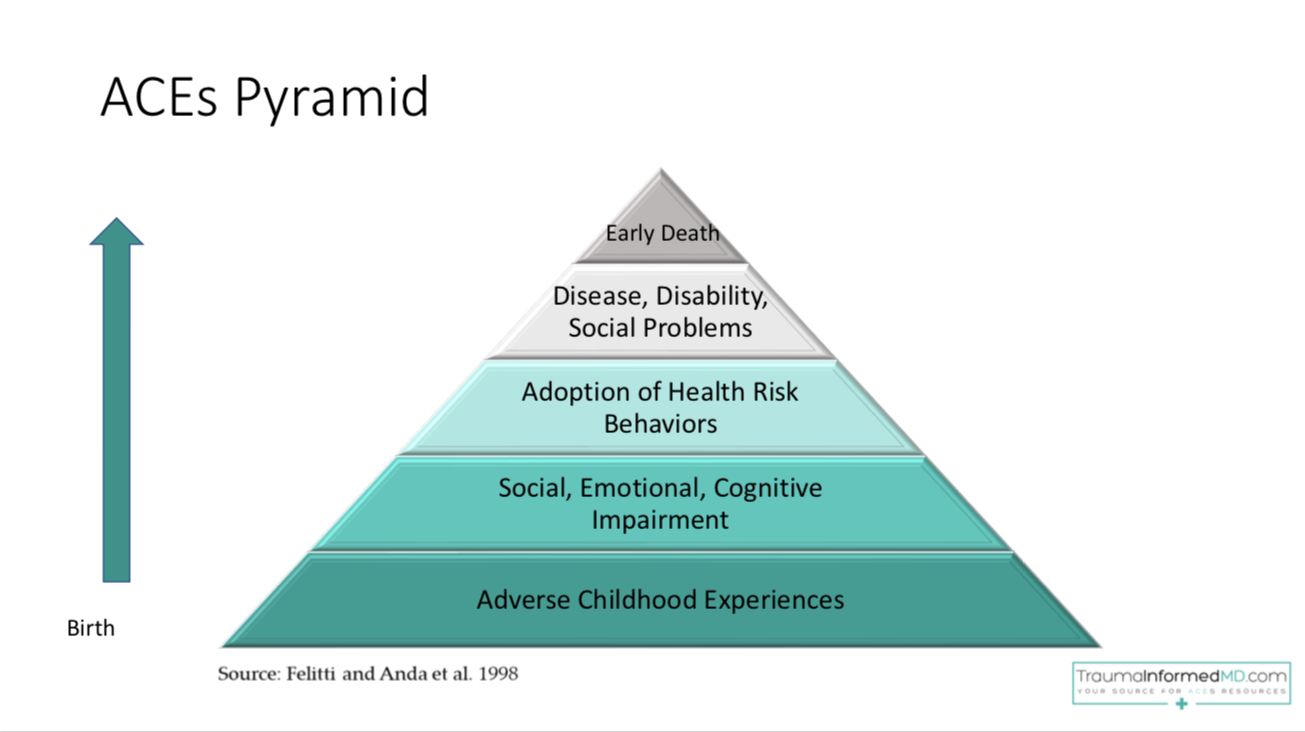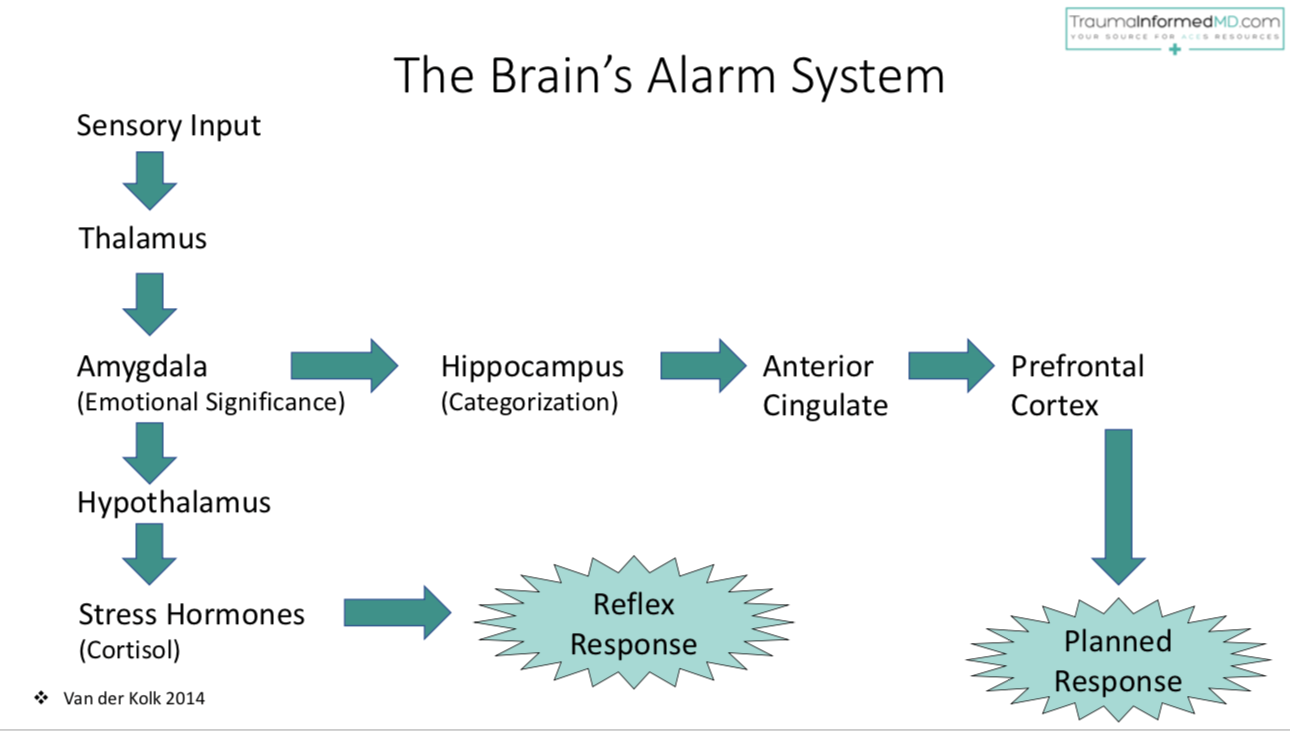WHAT IS TRAUMA?
TERMINOLOGY
THE ACEs STUDIES
- Trauma for our purposes is anything that causes an increased physiologic stress response in the body of an adult or child.
- Some Trauma in life is unavoidable – natural disasters, witnessing violence, being involved in accidents, undergoing scary medical procedures, etc.
- Trauma that is prolonged, frequent, intermittent, or unbuffered, with no ability for the person to defend themselves can result in the brain becoming “stuck” in an adaptive survival mode, which may result in decreased ability to learn, and behaviors that are less acceptable to society.
- The words Trauma, Toxic Stress, Complex Neurodevelopmental Trauma, Childhood Adversity, and Adverse Childhood Events (ACEs) are all used to describe the cause of this change in the brain. (https://www.nctsn.org/what-is-child-trauma/about-child-trauma)
TERMINOLOGY
- Trauma – may be a single or few isolated traumatic events; may also refer to the enduring effects on the physiology and behavior of a person who has been through toxic stress or complex trauma.
- Toxic Stress – when a person lives in an environment for a prolonged period of time where there is violence, chaos, lack of food, water, shelter, or warmth.
- Complex Neurodevelopmental Trauma – “the experience of multiple, prolonged, developmentally adverse traumatic events, most often of an interpersonal nature.” (Van der Kolk and Courtois 2005) for example child abuse, neglect, or institutionalization.
- Adverse Childhood Events – In 1998, researchers from Kaiser Permanente and the CDC published a groundbreaking article that showed a startling link between 10 adverse or traumatic events in childhood and the health and well-being of adults decades later.
THE ACEs STUDIES
- In 1998, Dr. Vince Felitti and Dr. Robert Anda published an article entitled “Relationship of Childhood Abuse and Household Dysfunction to Many of the Leading Causes of Death in Adults: The Adverse Childhood Events Study” in the American Journal of Preventative Medicine.
- They studied 17,421 middle class citizens of San Diego. They were 70% caucasian and 70% college-educated. They had good health insurance coverage with Kaiser Permanente.
- These study subjects were sent a questionnaire that asked about 10 kinds of adverse childhood experiences as well as current health risk-factors such as smoking, alcohol, drug abuse, and exposure to STDs. They also did full medical evaluations of each participant.
- The ACEs were separated into 10 categories, each positive answer for exposure to an ACE before the age of 18 years was given 1 point. So the ACE questionnaires were scored with a max number being 10. And the scores were then correlated to current risky behaviors and health outcomes.
OUTCOMES
To break down these graphs, this is what they are saying:
If a person had 4 or more Adverse Childhood Experiences........
1. They are twice as likely to smoke.
2. They are almost twice as likely to be severely obese.
3. They are 4.5 times more likely to suffer from depression at some time in your life.
4. They are 12 times more likely to attempt suicide at some time in your life.
5. They are 7 times more likely to consider yourself an alcoholic.
6. They are 4.5 times more likely to use illicit drugs.
7. They are 10 times more likely to have ever injected drugs.
8. They are 3 times more likely to have had more than 50 sexual partners.
9. They are over twice as likely to have ischemic heart disease (meaning risk for a heart attack).
10. They are almost twice as likely to get cancer of some kind.
11. They are more than twice as likely to have a stroke.
12. They are almost 4 times as likely to get COPD or Emphysema.
13. They are one and a half times more likely to get Diabetes.
These are all in comparison to someone who had 0 Adverse Childhood Experiences.
There are more than 40 outcomes that have been shown to have a similar dose-dependent effect of Adverse Childhood Experiences. These are not just social issues or bad choices. These include physical health risks due to the prolonged increase in cortisol as well as other biochemical and hormonal mechanisms.
If a person had 4 or more Adverse Childhood Experiences........
1. They are twice as likely to smoke.
2. They are almost twice as likely to be severely obese.
3. They are 4.5 times more likely to suffer from depression at some time in your life.
4. They are 12 times more likely to attempt suicide at some time in your life.
5. They are 7 times more likely to consider yourself an alcoholic.
6. They are 4.5 times more likely to use illicit drugs.
7. They are 10 times more likely to have ever injected drugs.
8. They are 3 times more likely to have had more than 50 sexual partners.
9. They are over twice as likely to have ischemic heart disease (meaning risk for a heart attack).
10. They are almost twice as likely to get cancer of some kind.
11. They are more than twice as likely to have a stroke.
12. They are almost 4 times as likely to get COPD or Emphysema.
13. They are one and a half times more likely to get Diabetes.
These are all in comparison to someone who had 0 Adverse Childhood Experiences.
There are more than 40 outcomes that have been shown to have a similar dose-dependent effect of Adverse Childhood Experiences. These are not just social issues or bad choices. These include physical health risks due to the prolonged increase in cortisol as well as other biochemical and hormonal mechanisms.
The original ACE study patients were followed up on 10 years later. People with 6 or more ACEs died an average of 20 years younger than those with 0 ACEs!!!!
THE PHYSIOLOGY OF TRAUMA
- The reptilian brain or brainstem develops in the womb and organizes basic life function; Sleep/Wake/Hunger/Breathing; it remains sensitive to threat throughout life.
- The limbic system and midbrain (Emotional Brain) develops in the first 6 years of life, but continues to evolve in a use-dependent way. It regulates emotion, memory, sensory input and lower level responses and hormone levels via the hypothalamus. (Sense of smell and eye movements are also regulated in this part of the brain.)
- The neocortex (Rational Brain) regulates motor commands, planning, empathy, inhibition of inappropriate actions, awareness of context, and more refined responses to sensory input. (Executive Function) It develops until the early 20’s and is always vulnerable to shutting down under perceived threat, which reverts the response to the Emotional brain.
HOW THE BODY RESPONDS TO TRAUMA
Fight or Flight – Autonomic, Sympathetic
REGULATION OF THE ALARM SYSTEM
THINGS THAT CAN GO WRONG
HOW THE BRAIN MAY COPE
COPING MECHANISMS
“People tend to prefer the certainty of misery over the misery of uncertainty” – attributed to Virginia Satir
Fight or Flight – Autonomic, Sympathetic
- Release of Cortisol
- Increased Blood Pressure, Increased Blood Sugar, Suppressed Immune System
- Increased Heart Rate
- Increased Oxygen Exchange in Lungs
- Constricted Blood Vessels in Skin and Digestive Tract and Shunt Blood to Muscles
- Pallor, Slowed or Stopped Digestion
- Dilated Pupils, Tunnel Vision
- Decreased Hearing
- Shaking, Trembling
- Dry Mouth, Dry Tears
- Faster Blood Clotting
- Acetylcholine mediated
- Slowed Heart Rate
- Slowed Breathing
- Lost sphincter tone (loss of continence)
- Awareness is shut down
- Awareness of Pain (endogenous opioids are released)
- Awareness of self, physical body, emotions
- May lose consciousness
REGULATION OF THE ALARM SYSTEM
- External Regulation – Babies require external input to regulate their nervous system. Such as skin to skin contact, swaddling, feeding, warmth. This regulates, breathing, heart rate, temperature, crying.
- Co-Regulation – from toddlerhood to preschool years, children rely on adults to help them regulate their emotions and sense of danger. Think about when a child falls and looks to their mother to see if she is upset, then the child will adjust their crying based on mom’s response.
- Self-Regulation – From 6 years old or so (without a history of trauma) a child begins to be able to regulate their own emotions and sense of danger. They should be able to calm themselves using their rational brain or neocortex to adjust emotional responses.
THINGS THAT CAN GO WRONG
- Shutdown or underutilization of Neocortex/Rational Brain- lack ability to distinguish false alarms from real danger, hypervigilance, poor planning, poor organization, poor ability to think about events and make adjustments in our responses within relationships. (ADHD-like behavior!)
- Shutdown of Thalamus – the Thalamus is the gatekeeper of sensations. It takes in all sensory input and helps you focus on what is important to you at the time, allows background noises or music to fade. If it is overwhelmed and shuts down you are wide open to all sensations and unable to block any out, therefore can’t concentrate and may be easily frustrated.
- Overuse or Inability to Dampen Amygdala – The Amygdala assigns emotional value to sensory input. It makes you respond with anger, fear, sadness, excitement. When over-used you may have emotional responses to minimal events like being bumped into, pulled over by cop, being cut off in traffic, etc.
- Lost Sense of Time - The Dorsolateral Prefrontal Cortex regulates our sense of time. It can be overwhelmed in Trauma and shut down, leading to a feeling that the Trauma is always present and will last forever even after it has passed.
HOW THE BRAIN MAY COPE
- Dissociation – When an experience is overwhelming to the Alarm system, the experience of it or memories may be split off from integrated memory and fragmented into pieces of sights, smells, sounds, voices, images, thoughts, etc. This is one way the brain separates itself from something it can’t handle all together.
- Flashbacks – when sensory input is similar to those that have been fragmented and put away they can trigger the whole physiologic response, as if the traumatic event was happening again in the present. Cortisol is released and the Neocortex or Rational Brain is turned down.
- Numbing - After a long period of time of experiencing a heightened level of stress with frequent flashbacks, the brain may “numb out.” All sensory input is then downplayed and the person can no longer experience good or bad sensations. (May be helped along with substance abuse)
- Depersonalization – Some people cope with traumatic events or inescapable stressors by blanking out. They may have a blank stare, absent mind, and lowered heart rate and respiratory rate. On fMRI almost all areas of the brain show decreased activity! This is the physiological Freeze response. People who have responded this way during a traumatic event may later similarly blank out when they feel threatened or have memories of the event. This can go as far as losing consciousness for unknown reasons. Or, it may be mistaken for ADD – inattentive type. These people may have loss of body awareness or sensations on a regular basis also.
COPING MECHANISMS
- Many survivors of childhood trauma have developed coping mechanisms that helped them survive in their childhood environment
- Indiscriminate affection to adults, inappropriate laughter, hoarding food, and other behaviors may be learned coping mechanisms
“People tend to prefer the certainty of misery over the misery of uncertainty” – attributed to Virginia Satir
- Victims of trauma may provoke chaos, harsh punishments, emotional drama, etc. because it feels normal and is more predictable to them.
- Girls who feel sexual abuse is inevitable may act provocatively because they were conditioned to, or because it is a way of controlling the situation or timing of abuse.
- Children from hard places will often test boundaries in relationships with trusted adults – just like a normal 1-3 year old will do. They are figuring out to what extent they can trust this adult.
THE ROLE OF DEVELOPMENT IN THE TIMING OF TRAUMA
TIMING OF TRAUMA
MIXED MATURITY
–Experiential age or street smarts may be 20
–Emotional age may be 5
Emotional age is frequently around half of chronological age without treatment or healthy attachment relationships.
Developmental abilities often vary WIDELY in the same child due to lack of specific experiences and exposure to other experiences. When making house rules for children with a background of trauma its best to take into account what you think their emotional age is, rather than allowing them to do what other kids their age are allowed to do. They may not have the emotional maturity or ability to control impulses and make good decisions that other kids their age should have. This is not a punishment, but should be seen as nurturing them for a longer period of time to allow them to catch up in maturity.
- When trauma takes place during infancy the establishment of Trust may be interrupted. Especially if the primary caregiver is inconsistent or changes. The baby may come to feel he can’t trust the world to meet his needs. His further development and organization is therefore hindered, delayed or disorganized.
- When trauma takes place in toddlerhood, they may halt exploration of the world around them, clinging to their caregiver with a feeling the world may not be safe to explore. This may delay cognitive development in many areas. If the caregiver is inconsistent or changes/leaves, the child also may feel they cannot leave their new caregiver to explore, as they may also leave. Or they may stop relying on a caregiver as a secure base. In future, they may handle fears and difficulties alone without the buffer of a caregiver, also delaying development of higher cognitive abilities.
- When trauma takes place in the preschool years, the child may internalize it and feel guilt as if somehow responsible. Think of children this age who often feel responsible for their parents’ divorce.
- When trauma happens in school age (6-12yrs), a child may lose interest in learning new things, playing, special interests. They may fall behind peers and start to feel inferior.
- When trauma happens in adolescence, the child may be more likely to feel it reflects on their worth or role in society. They may have more identity confusion and feel more need to fit in with a group.
- When trauma happens in young adulthood, the person may be more likely to isolate themselves. They may have difficulty trusting close friends or intimate partners.
MIXED MATURITY
- It is widely accepted in the trauma and adoption community that a child who has a background of trauma including abuse or neglect they frequently have a range of functional ages.
–Experiential age or street smarts may be 20
–Emotional age may be 5
Emotional age is frequently around half of chronological age without treatment or healthy attachment relationships.
Developmental abilities often vary WIDELY in the same child due to lack of specific experiences and exposure to other experiences. When making house rules for children with a background of trauma its best to take into account what you think their emotional age is, rather than allowing them to do what other kids their age are allowed to do. They may not have the emotional maturity or ability to control impulses and make good decisions that other kids their age should have. This is not a punishment, but should be seen as nurturing them for a longer period of time to allow them to catch up in maturity.
UNDERSTANDING THE CONSEQUENCES
IN SUMMARY
THE NEXT GENERATION
- Toxic stress and traumatic events cause a release of Cortisol which may pass from being helpful to being detrimental when it continues for a prolonged time, or does not resolve naturally.
- This increased Cortisol can cause increased Heart Rate, Blood Pressure, blood glucose, and decreased immune system function.
- This may lead to frequent illness which in itself increases stress by causing lost time at work for the parent, daycare issues, doctor visits and costs.
- It may also lead to behavioral changes caused by continued hypervigilance, hyperactivity, disassociation, difficulty learning or remembering new information, aggression, impulse control problems, and extreme emotions.
- These cognitive difficulties and behavior issues make learning and getting along at school difficult. In turn, this may limit the child’s choices for future employment or make dropping out more likely. Impulse control problems and lack of engagement in school may make teen pregnancy more likely.
- With difficulty controlling their fear response and emotional regulation, interactions with law enforcement may spiral out of control without any intention to do so.
- Rational brain development and attachment relationships are necessary to develop empathy. When this goes wrong we sometimes end up with socio-paths, or those that harm others without a clear understanding of the pain they are causing or ability to have remorse (this is definitely the exception, but the mechanism is here.)
- Job training programs and even parenting skills classes can have limited results due to poor memory and emotional regulation as a result of a traumatic childhood.
- Victims of trauma often lose some of the ability to recognize real danger. They may not catch social cues that would warn others that a person or situation may be dangerous. This puts them at a much higher likelihood of re-victimization.
- Victims of trauma often have trouble with intimacy and healthy relationships in adulthood. They may have loss of sensation or awareness of parts of their physical body. They may blank out or become aggressive when conflict starts to arise.
- Victims of trauma can feel anxious all the time with high cortisol levels. If they come in contact with substances like alcohol, marijuana, opioids and many other drugs, these can alleviate the stress effect, making them feel “normal.” They are then predisposed to becoming addicted.
- Similarly, self harm or cutting is another way of triggering endogenous opioids and is a way of self-medicating.
- As we’ve already seen there are many mental health and physical health consequences to Childhood Adversity and Toxic Stress. Virtually every system of the body is affected, for life.
THE NEXT GENERATION
- As you can now imagine, parents who have themselves been the victims of untreated, unbuffered trauma, abusive or neglectful childhoods, or insecure attachments at a young age have an uphill battle in learning the skills to keep their own emotional regulation under control in order to externally regulate and co-regulate with their child.
- If they have not been given the skills or opportunity to learn positive, healthy relationships, and the ability to use the rational brain or neocortex to control the emotional brain or limbic system, then they have a high risk of traumatizing their own children whether they have children in their teen years or later.
- But THERE IS HOPE! Trauma is at least to some extent TREATABLE. It is also PREVENTIBLE in many cases! Let’s talk about RESILIENCE!
Proudly powered by Weebly

